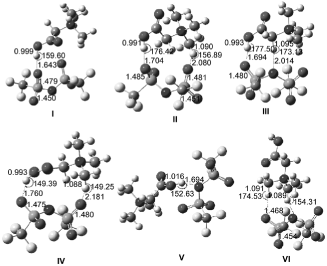化学学报 ›› 2011, Vol. 69 ›› Issue (22): 2682-2690. 上一篇 下一篇
研究论文
吴阳*,范翠娥,张丽娜,孔玉霞
WU Yang, FAN Cui-E, ZHANG Li-Na, KONG Yu-Xia

利用密度泛函理论(DFT)方法, 在B3LYP/6-311+G(d,p)水平下, 对质子化甜菜碱阳离子与双三氟甲磺酰亚胺阴离子形成的气态阴阳离子对([Hbet][Tf2N])进行理论研究, 通过几何结构优化和频率分析得到势能面上的六个稳定构型. 计算结果表明[Hbet]+和[Tf2N]-之间能够形成较强的氢键相互作用, 氢键相互作用的稳定化能主要来源于[Tf2N]-中O, N原子的孤对电子和[Hbet]+中参与形成氢键的O—H, C—H反键轨道之间的相互作用. 自然布局分析(NPA)给出气态[Hbet][Tf2N]离子对中阴阳离子间的电荷转移比传统离子液体中电荷转移的数值小. AIM (atoms in molecules)分析得到[Hbet]+和[Tf2N]-之间的氢键相互作用以静电作用为主. 通过实验和理论结果相比较, 初步探讨影响离子液体熔点及其对金属离子选择性溶解的结构因素.